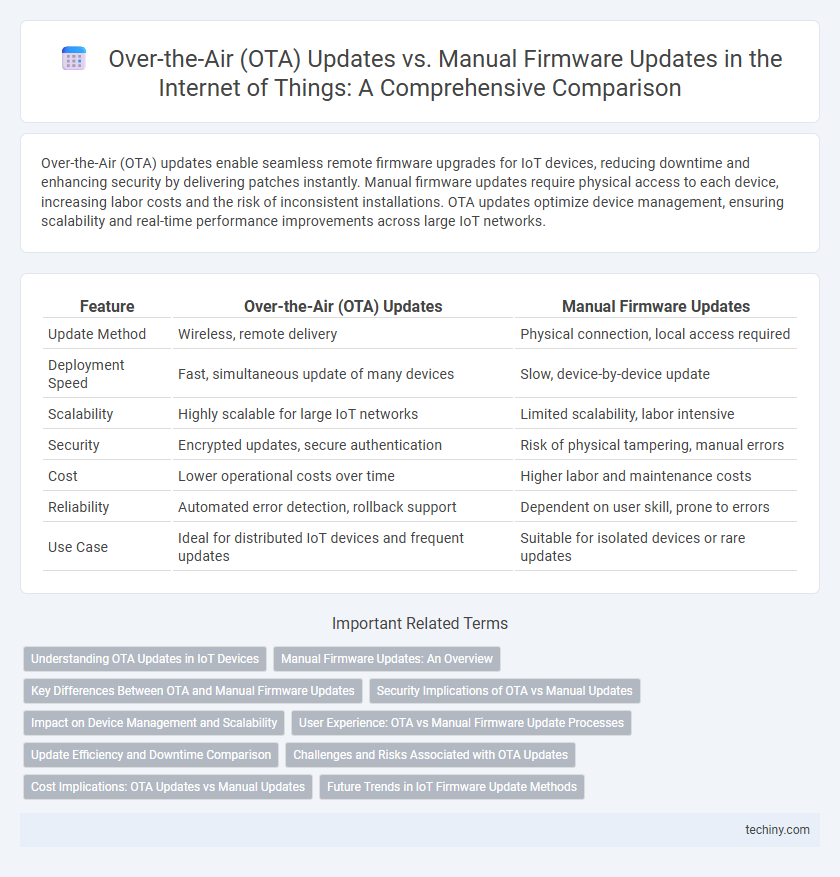Over-the-Air (OTA) updates enable seamless remote firmware upgrades for IoT devices, reducing downtime and enhancing security by delivering patches instantly. Manual firmware updates require physical access to each device, increasing labor costs and the risk of inconsistent installations. OTA updates optimize device management, ensuring scalability and real-time performance improvements across large IoT networks.
Table of Comparison
| Feature | Over-the-Air (OTA) Updates | Manual Firmware Updates |
|---|---|---|
| Update Method | Wireless, remote delivery | Physical connection, local access required |
| Deployment Speed | Fast, simultaneous update of many devices | Slow, device-by-device update |
| Scalability | Highly scalable for large IoT networks | Limited scalability, labor intensive |
| Security | Encrypted updates, secure authentication | Risk of physical tampering, manual errors |
| Cost | Lower operational costs over time | Higher labor and maintenance costs |
| Reliability | Automated error detection, rollback support | Dependent on user skill, prone to errors |
| Use Case | Ideal for distributed IoT devices and frequent updates | Suitable for isolated devices or rare updates |
Understanding OTA Updates in IoT Devices
Over-the-Air (OTA) updates enable seamless remote firmware upgrades for IoT devices, eliminating the need for physical access and reducing downtime. This method supports real-time deployment of security patches and feature enhancements, ensuring devices maintain optimal performance and protection against vulnerabilities. OTA updates enhance scalability and operational efficiency in IoT ecosystems by automating the update process across distributed device networks.
Manual Firmware Updates: An Overview
Manual firmware updates in IoT devices require physical access to each device for installation, often involving USB connections or memory card swaps. This process is time-consuming, prone to human error, and less efficient in large-scale deployments compared to Over-the-Air (OTA) updates. Despite these challenges, manual updates remain essential in environments lacking secure network connectivity or when devices operate in isolated locations.
Key Differences Between OTA and Manual Firmware Updates
Over-the-Air (OTA) updates enable remote firmware deployment directly to IoT devices via wireless networks, minimizing downtime and eliminating the need for physical access, whereas manual firmware updates require on-site intervention and device connection, increasing labor and time costs. OTA updates support mass distribution, version control, and automated rollback options, enhancing scalability and reliability, in contrast to manual updates that are prone to human error and inconsistent deployment. Security protocols are integral to OTA processes to safeguard against cyber threats, while manual updates often rely on individual procedural rigor, making OTA a more efficient and secure solution for maintaining IoT device functionality.
Security Implications of OTA vs Manual Updates
Over-the-Air (OTA) updates for Internet of Things (IoT) devices significantly reduce the risk of security breaches by enabling encrypted, authenticated, and automated firmware distribution, minimizing human error and exposure time compared to manual updates. Manual firmware updates often require physical access, increasing the likelihood of unauthorized interventions and vulnerabilities arising from outdated software during delayed patch cycles. OTA updates integrate real-time monitoring and rollback features, enhancing device integrity and resilience against cyber threats, whereas manual processes typically lack such proactive security controls.
Impact on Device Management and Scalability
Over-the-Air (OTA) updates streamline device management by enabling remote, real-time firmware upgrades across vast IoT networks, significantly reducing downtime and human intervention. Manual firmware updates, conversely, increase operational complexity and limit scalability due to the need for physical access to devices, resulting in slower deployment cycles. OTA updates enhance scalability by supporting automated, secure, and consistent firmware delivery, vital for maintaining large-scale IoT ecosystems efficiently.
User Experience: OTA vs Manual Firmware Update Processes
Over-the-Air (OTA) updates streamline the firmware update process by enabling remote delivery and installation, minimizing device downtime and reducing user effort. Manual firmware updates require physical connection or user intervention, often leading to longer update times and increased risk of errors. OTA updates enhance user experience by providing seamless, automatic maintenance that keeps Internet of Things (IoT) devices secure and up-to-date without disrupting daily operations.
Update Efficiency and Downtime Comparison
Over-the-Air (OTA) updates deliver firmware enhancements wirelessly, significantly reducing update time and minimizing device downtime compared to manual firmware updates that require physical access and longer maintenance windows. OTA updates enable real-time deployment across large IoT networks, ensuring consistent and rapid update cycles while manual methods often lead to staggered updates and prolonged operational interruptions. Efficient OTA processes contribute to improved device uptime, security patching speed, and overall system reliability in IoT ecosystems.
Challenges and Risks Associated with OTA Updates
Over-the-Air (OTA) updates in the Internet of Things face significant challenges including security vulnerabilities, risk of failed updates causing device bricking, and network dependency that may interrupt firmware delivery. Unauthorized access during OTA transmission can lead to data breaches and exploitation of device controls, making robust encryption and authentication essential. Manual firmware updates, while more labor-intensive, mitigate these risks by allowing controlled, localized update processes without reliance on network stability or exposure to remote attacks.
Cost Implications: OTA Updates vs Manual Updates
Over-the-Air (OTA) updates significantly reduce operational costs by eliminating the need for physical access to IoT devices and associated labor expenses, streamlining firmware deployment across vast device networks. Manual firmware updates involve higher costs due to on-site technician visits, increased downtime, and logistical challenges, especially in geographically dispersed environments. Economies of scale favor OTA solutions, lowering per-device update costs and enhancing overall maintenance efficiency for IoT ecosystems.
Future Trends in IoT Firmware Update Methods
Future trends in IoT firmware update methods emphasize expanding Over-the-Air (OTA) updates due to their efficiency, scalability, and reduced downtime compared to manual firmware updates. Enhanced security protocols such as blockchain integration and AI-driven anomaly detection are being developed to safeguard OTA processes from cyber threats. The adoption of edge computing also facilitates more localized and faster firmware updates, reducing reliance on central servers and enabling real-time device maintenance.
Over-the-Air (OTA) Updates vs Manual Firmware Updates Infographic

 techiny.com
techiny.com